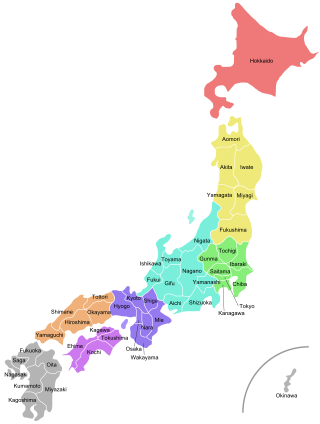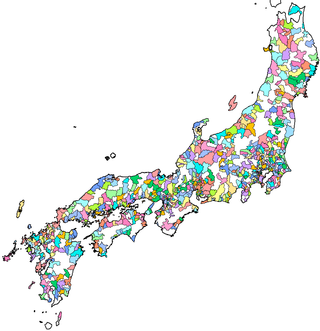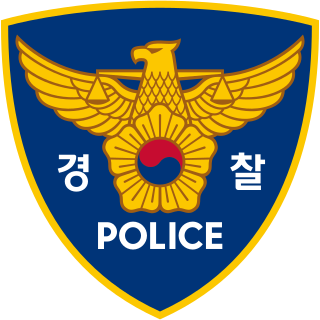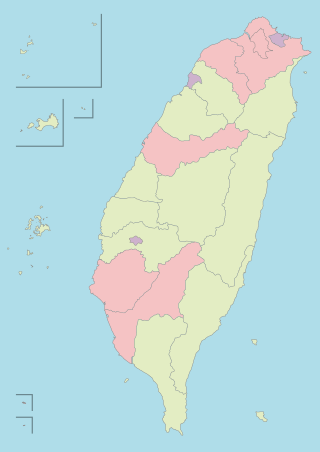
A municipality is usually a single administrative division having corporate status and powers of self-government or jurisdiction as granted by national and regional laws to which it is subordinate.
An independent city or independent town is a city or town that does not form part of another general-purpose local government entity.

Japan is divided into 47 prefectures, which rank immediately below the national government and form the country's first level of jurisdiction and administrative division. They include 43 prefectures proper, two urban prefectures, one regional prefecture and one metropolis. In 1868, the Meiji Fuhanken sanchisei administration created the first prefectures to replace the urban and rural administrators in the parts of the country previously controlled directly by the shogunate and a few territories of rebels/shogunate loyalists who had not submitted to the new government such as Aizu/Wakamatsu. In 1871, all remaining feudal domains (han) were also transformed into prefectures, so that prefectures subdivided the whole country. In several waves of territorial consolidation, today's 47 prefectures were formed by the turn of the century. In many instances, these are contiguous with the ancient ritsuryō provinces of Japan.
Taiwan is divided into multi-layered statutory subdivisions. Due to the complex political status of Taiwan, there is a significant difference in the de jure system set out in the original constitution and the de facto system in use today.

A city is a local administrative unit in Japan. Cities are ranked on the same level as towns and villages, with the difference that they are not a component of districts. Like other contemporary administrative units, they are defined by the Local Autonomy Law of 1947.

Special wards are a special form of municipalities in Japan under the 1947 Local Autonomy Law. They are city-level wards: primary subdivisions of a prefecture with municipal autonomy largely comparable to other forms of municipalities.

A city designated by government ordinance, also known as a designated city or government ordinance city, is a Japanese city that has a population greater than 500,000 and has been designated as such by order of the Cabinet of Japan under Article 252, Section 19, of the Local Autonomy Law.

A core city is a class or category of Japanese cities. It is a local administrative division created by the national government. Core cities are delegated many functions normally carried out by prefectural governments, but not as many as designated cities. To become a candidate for core city status, a city must have a population greater than 300,000 and an area greater than 100 square kilometers, although special exceptions may be made by order of the cabinet for cities with populations under 300,000 but over 200,000. After the abolition of special city status on April 1, 2015, any city with a population above 200,000 may apply for core city status.
South Korea is made up of 17 first-tier administrative divisions: 6 metropolitan cities, 1 special city, 1 special self-governing city, and 9 provinces, including two special self-governing provinces. These are further subdivided into a variety of smaller entities, including cities, counties, districts, towns, townships, neighborhoods and villages.
A capital district, capital region, or capital territory is normally a specially designated administrative division where a country's seat of government is located. As such, in a federal model of government, no state or territory has any political or economic advantage relative to the others because of the national capital lying within its borders. A capital territory can be a specific form of federal district.

The bureaucratic administration of Japan is divided into three basic levels: national, prefectural, and municipal. They are defined by the Local Autonomy Law of 1947.

Provinces are one of the first-level divisions within South Korea. There are 9 provinces in South Korea: North Chungcheong, South Chungcheong, Gangwon Special Self-Governing Province, Gyeonggi, North Gyeongsang, South Gyeongsang, North Jeolla, South Jeolla, and Jeju Special Self-Governing Province.

The Government of South Korea is the national government of the Republic of Korea, created by the Constitution of South Korea as the executive, legislative and judicial authority of the republic. The president acts as the head of state and is the highest figure of executive authority in the country, followed by the prime minister and government ministers in decreasing order.

The Korean National Police Agency (KNPA), also known as the Korean National Police (KNP), is one of the national police organizations in South Korea. It is run under the Ministry of the Interior and Safety and is headquartered in Seodaemun, Seoul. The agency is divided into 18 local police agencies, including the Seoul Metropolitan Police Agency. Local police agencies are not independent of the national police.

Sejong, officially the Sejong Special Self-Governing City, is a special self-governing city and the de facto administrative capital of South Korea.
A dong (Korean: 동) or neighborhood is a submunicipal level administrative unit of a city and of those cities which are not divided into wards throughout Korea. The unit is often translated as neighborhood and has been used in both administrative divisions of North Korea and South Korea.

Special municipality, historically known as Yuan-controlled municipality, is a first-level administrative division unit in Taiwan. Under the administrative structure of Taiwan, it is the highest level of division in Taiwan and is equivalent to a province. Since the streamlining of provinces in 1998, the special municipalities along with provincial cities and counties have all governed directly under the central government of Taiwan.

The Fire Service in South Korea is an organization to prevent danger, to protect the Republic of Korea people's lives and property, fire suppression and rescue, relief of emergency patients, prevention of disaster, disaster response, and providing recovery after a disaster occurs. Fire fighters in South Korea are Fire officers, members of an obligatory fire-fighting unit, and volunteer fire fighters. Regarding fire fighting activities, the Framework Act on Fire Service, rescue and emergency activities are regulated by Act of 119 Rescue and Emergency Medical Services. The national fire department is the responsibility of the Ministry of Public Safety and Security, and the local fire department is in charge of the city and circuit fire headquarters.




















